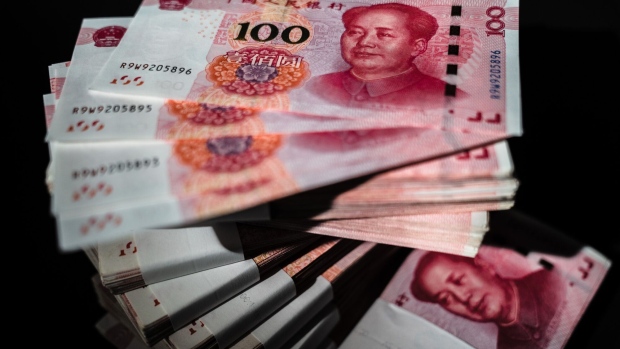Apr 15, 2024
China Loosens Grip on Yuan by Weakening Fix Amid Dollar Strength
, Bloomberg News

(Bloomberg) -- China unexpectedly weakened its yuan defense as pressure from a resurgent dollar and poor sentiment pushed it toward a policy red line.
The People’s Bank of China broke out of a holding pattern and set a weaker daily reference rate for the managed currency, implying some flexibility for it to depreciate alongside regional peers amid broad strength in the dollar. The offshore yuan slid as much as 0.3% to lowest since November in reactions to the so-called fixing.
China watchers have been eyeing the fixing for signs of where Beijing wants to guide the currency after it weakened to within a whisker of the edge of its trading range recently. On Monday, the onshore yuan hit a five-month low, after a fresh round of hot US inflation data bolstered the greenback and Treasury yields.
“The PBOC is bowing to reality, with dollar broadly higher and onshore dollar demand surging,” said Richard Franulovich, head of foreign-exchange strategy at Westpac Banking Corp. “They obviously want to control and contain the move though, so they are guiding yuan lower in a moderate and steady fashion.”
The PBOC set the fixing, around which the currency is then permitted to trade in a 2% range, at 7.1028 per dollar. In the onshore market, the yuan was little changed at 7.2355 and was within a whisker of the edge of its trading band.
Officials have been vigilant of yuan pressure which can spill over to Chinese assets and restrict its room to ease monetary policy, despite the fact that the country’s exporters would benefit from a weaker currency. Tuesday morning, state-owned banks actively sold large amount of dollar to support the yuan in the onshore market, according to traders who asked not to be identified.
Still, that’s not deterring yuan bears who believe the currency will weaken eventually amid the nation’s sluggish economic recovery. Longing the greenback against the yuan stands out as an investor near-term favorite China trade, according to a Bank of America Corp. report published Friday. The onshore currency may drop to levels between 7.3 and 7.4, the respondents said.
China’s activity data for March further backed up traders’ bets the yuan will have room to weaken. The nation’s retail sales and industrial production missed economists’ forecast last month, though its gross domestic product grew more than expected, according to the National Bureau of Statistics.
Before Tuesday, the Chinese currency already started to looking expensive. The offshore yuan was at its strongest level on record against the yen earlier this week, and the onshore rate rose to the highest since May 2023 versus trading partners’ currencies.
“Relaxing the fixing will allow the yuan to better reflect market-oriented demand and supply dynamics, and reduce yuan’s strength on a trade-weighted-basket level,” said Becky Liu, head of Greater China macro strategy at Standard Chartered Bank, “I think it is the right way to go.”
Stability Anchor
Swings in the yuan have implications far beyond China. As a source of stability in the global foreign-exchange market and an anchor for its regional peers, an increase in yuan volatility risks spilling over into other exchange rates. Emerging-market currencies fell to a new low for the year, with the Korean won and Indonesian rupiah sliding more than 1%.
“The authorities are allowing room for a bit more yuan weakness,” said Khoon Goh, head of Asia research at ANZ Group Holdings Ltd. Given persistent dollar strength with US yields rising, “it is likely that the authorities are now more open to a slight depreciation in the yuan.”
--With assistance from Ran Li.
(Updates throughout.)
©2024 Bloomberg L.P.






